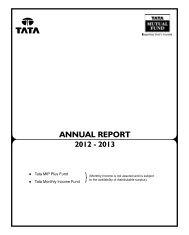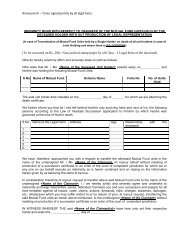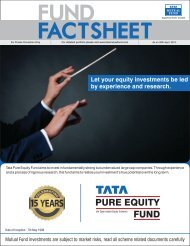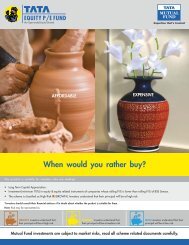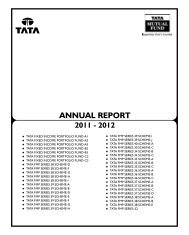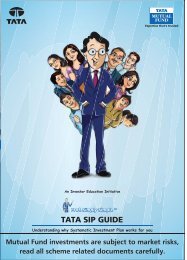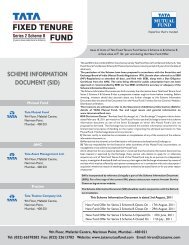Front Cover Page - Tata Mutual Fund
Front Cover Page - Tata Mutual Fund
Front Cover Page - Tata Mutual Fund
You also want an ePaper? Increase the reach of your titles
YUMPU automatically turns print PDFs into web optimized ePapers that Google loves.
TATA FLOATER FUND<br />
Personal Loans<br />
The main risks pertaining to each of the asset classes above are described below:<br />
Auto Loans (cars / commercial vehicles /two wheelers)<br />
The underlying assets (cars etc) are susceptible to depreciation in value whereas the loans are given at high loan to value ratios. Thus, after a<br />
few months, the value of asset becomes lower than the loan outstanding. The borrowers, therefore, may sometimes tend to default on loans<br />
and allow the vehicle to be repossessed.<br />
These loans are also subject to model risk. ie if a particular automobile model does not become popular, loans given for financing that model<br />
have a much higher likelihood of turning bad. In such cases, loss on sale of repossession vehicles is higher than usual.<br />
Commercial vehicle loans are susceptible to the cyclicality in the economy. In a downturn in economy, freight rates drop leading to higher<br />
defaults in commercial vehicle loans. Further, the second hand prices of these vehicles also decline in such economic environment.<br />
Housing Loans<br />
Housing loans in India have shown very low default rates historically. However, in recent years, loans have been given at high loan to value<br />
ratios and to a much younger borrower classes. The loans have not yet gone through the full economic cycle and have not yet seen a period of<br />
declining property prices. Thus the performance of these housing loans is yet to be tested and it need not conform to the historical experience<br />
of low default rates.<br />
Consumer Durable Loans<br />
The underlying security for such loans is easily transferable without the bank’s knowledge and hence repossession is difficult.<br />
The underlying security for such loans is also susceptible to quick depreciation in value. This gives the borrowers a high incentive to default.<br />
Personal Loans<br />
These are unsecured loans. In case of a default, the bank has no security to fall back on.<br />
The lender has no control over how the borrower has used the borrowed money.<br />
Further, all the above categories of loans have the following common risks:<br />
All the above loans are retail, relatively small value loans. There is a possibility that the borrower takes different loans using the same income<br />
proof and thus the income is not sufficient to meet the debt service obligations of all these loans.<br />
In India, there is no ready database available regarding past credit record of borrowers. Thus, loans may be given to borrowers with poor credit<br />
record.<br />
In retail loans, the risks due to frauds are high.<br />
Securities Lending Risks<br />
It may be noted that this activity would have the inherent probability of collateral value drastically falling in times of strong downward market trends,<br />
rendering the value of collateral inadequate until such time as that diminution in value is replenished by additional security. It is also possible that<br />
the borrowing party and/or the approved intermediary may suddenly suffer severe business setback and become unable to honour its commitments.<br />
This, along with a simultaneous fall in value of collateral would render potential loss to the Scheme. Besides, there is also be temporary illiquidity of<br />
the securities that are lent out and the scheme will not be able to sell such lent out securities until they are returned.<br />
As with other modes of extensions of credit, there are risks inherent to securities lending, including the risk of failure of the other party, in this case<br />
the approved intermediary, to comply with the terms of the agreement entered into between the lender of securities i.e. the scheme and the<br />
approved intermediary. Such failure can result in the possible loss of rights to the collateral put up by the borrower of the securities, the inability of<br />
the approved intermediary to return the securities deposited by the lender and the possible loss of any corporate benefits accruing to the lender<br />
from the securities deposited with the approved intermediary.<br />
Interest Rate Risk<br />
As with debt instruments, changes in interest rate may affect the Scheme’s net asset value. Generally the prices of instruments increase as interest<br />
rates decline and decrease as interest rates rise. Prices of long-term securities fluctuate more in response to such interest rate changes than shortterm<br />
securities. Indian debt and government securities markets can be volatile leading to the possibility of price movements up or down in fixed<br />
income securities and thereby to possible movements in the NAV.<br />
Credit Risk<br />
Credit risk or Default risk refers to the risk that an issuer of a fixed income security may default (i.e. the issuer will be unable to make timely principal<br />
and interest payments on the security). Because of this risk corporate debentures are sold at a higher yield above those offered on Government<br />
Securities which are sovereign obligations and free of credit risk. Normally, the value of fixed income securities will fluctuate depending upon the<br />
changes in the perceived level of credit risk as well as any actual event of default. The greater the credit risk, the greater the yield required for<br />
someone to be compensated for the increased risk.<br />
Reinvestment Risk<br />
This risk refers to the difference in the interest rate levels at which cash flows received from the securities in the schemes are reinvested. The<br />
additional income from reinvestment is the “interest on interest” component. The risk is that the rate at which interim cash flows are reinvested may<br />
be lower than that originally assumed.<br />
Risks associated with Derivatives<br />
Derivative products are leverage instruments and can provide disproportionate gains as well as disproportionate losses to the investors.<br />
Execution of such strategies depends upon the ability of the <strong>Fund</strong> Manager to identify such opportunities. Identification and execution of the<br />
strategies to be pursued by the <strong>Fund</strong> Manager involved uncertainty and decision of <strong>Fund</strong> Manager may not always be profitable. No assurance<br />
can be given that the <strong>Fund</strong> Manager will be able to identify or execute such strategies.<br />
7




